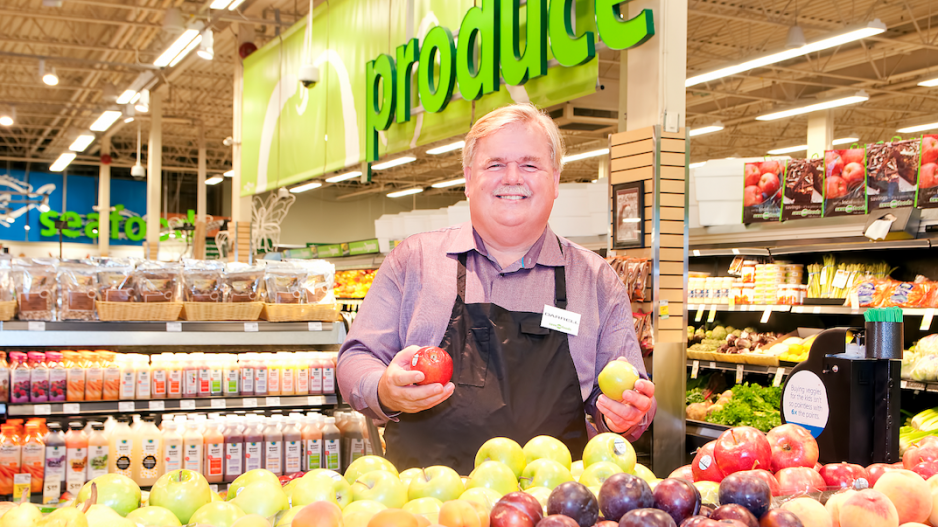Grocers across North America share the challenges of sagging sales and falling profit while issuing dismal outlooks and enduring sinking share prices.
The cause of their struggles, however, is substantially different in Canada than in the U.S.
Food prices rose 1.1% in Canada in August compared to a year earlier, according to Statistics Canada. In the U.S., food prices have fallen for nine consecutive months and the country is on track for its longest stretch of food deflation in 50 years, according to the U.S. Bureau of Labor Statistics.
This has taken place in a year when the Canadian dollar exchange rate has been relatively flat.
Much of the reason for the difference in the inflation rates is that Canada has dairy marketing boards. Those boards control the cost of milk, eggs and other items to rein in market volatility at the producer level, according to Ben Janzen, who is chairman of the B.C. Milk Marketing Board. Processors then buy the dairy products at a stable price that is not influenced by supply surges or shortages.
“It’s a free market system after that,” Janzen said.
In the U.S., the initial supply from farmers has a much bigger impact on the final retail price. There, the price of a gallon of milk was down 11% to $3.06 in July, compared to the same month a year ago, while the price of a dozen large eggs fell 40% to $1.55 in the same period, according to the Wall Street Journal.
In Canada, dairy product prices increased a modest 0.1% in August, whereas egg prices have risen 0.6%, according to Statistics Canada.
Price wars are raging on both sides of the border, although for different reasons.
In the more fragmented U.S. grocery sector, price wars stem from grocers aiming to increase or sustain market share while the biggest grocery seller in the nation, Walmart, expands selection and locations.
Walmart has yet to open freestanding grocery stores in Canada although Desjardins analyst Keith Howlett wrote in a note to investors in May that he expects those to open within the next three years.
In the meantime, price wars in the Canadian grocery sector have been focused mostly on regions such as Alberta, which have been hit hard by the slump in oil prices and the fire in Fort McMurray earlier this year.
Empire Co. Ltd. (TSX:EMP.A) revealed September 15 that the “continued negative impact of merchandising and promotional strategies in Western Canada” was among the main reasons why its sales for the quarter that ended on August 6 were down $62.6 million, or 1%.
“The decrease was partially offset by food inflation,” Empire noted in its management’s explanation of the company’s operating results. The company’s share price then slumped 6.4% in the next two trading sessions.
That pales in comparison to stock price slides for U.S. grocers following their recent earnings. Supervalu (NYSE:SVU), for example, fell 9.5% on September 8 while Sprouts Farmers Market (Nasdaq:SFM) fell 13.7% on September 7.
Loblaw Companies Ltd. (TSX:L), meanwhile, set off ripples in the grocery sector earlier this year when it sent a notice to suppliers requesting that they reduce prices by 1.45%.
United Grocers Inc., which is a buying group for companies such as London Drugs and the Overwaitea Food Group (OFG), then wrote to suppliers to ask for the same rates as those given to Loblaw.
Regardless of whether that tactic reverses the trend toward ever-slimmer profit margins, OFG president Darrell Jones said his company has been seeing opportunity in Alberta.
That is in part because Empire Co. bought Canada Safeway in 2013, he explained to Business in Vancouver.
“There are fewer competitors,” he said of OFG’s push to open new stores in Alberta and as far east as Manitoba. “If you take two competitors, like Safeway and [Empire-owned] Sobey’s and put them into one, that ended up eliminating an entire flyer, or grocery banner, from the marketplace. They now operate as one flyer.”
Jones said that discounting and the struggling economy is a challenge because “people are watching their pennies” but that price is only one part of providing value.
Having high-quality products and the ability to provide services such as online ordering and either delivery or pick-up areas in the stores are other ways to attract customers, he said. •




